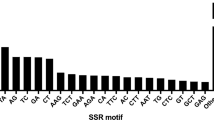Abstract
Sinocalycanthus chinensis, an endangered species endemic to China, is cultivated as an ornamental landscape tree in China. However, S. chinensis, Chimonanthus species and Calycanthus floridus are difficult to be distinguished in seedling market because of their similar morphological characters. In this study, ISSR (inter-simple sequence repeats) were applied to detect S. chinensis from its closely related species. A unique 748-bp band was found in all accessions of S. chinensis. SCAR (sequence characterized amplified regions) markers were created by cloning and sequencing the specific band, and designing a pair of primers to amplify the band of 748 bp. Diagnostic PCRs were performed using the primer pair with the total DNAs of S. chinensis, Chimonanthus species and C. floridus as templates, with only S. chinensis being able to be amplified. This amplification is not only rapid (results can be obtained in less than 3 h), but is also easy to perform. Hence it is a feasible method for identifying S. chinensis in seedling market.
Similar content being viewed by others
References
Bandana, D., Mahipal, S., 2003. Molecular detection of cashew husk (Anacardium occidentale) adulteration in market samples of dry tea (Camellia sinensis). Planta Med., 69(9):882–884. [doi:10.1055/s-2003-43211]
Camacho, F.J., Liston, A., 2001. Population structure and genetic diversity of Botrychium pumicola (Ophioglossaceae) based on ISSR. Am. J. Bot., 88(6):1065–1070.
Doyle, J.J., 1991. DNA Protocols for Plants—CTAB Total DNA Isolation. In: Hewitt, G.M., Johnston, A. (Eds.), Molecular Techniques in Taxonomy. Springer-Verlag, Berlin, Germany, p.283–293.
Elizabeth, A.S., Michael, D.C., Geunhwa, J., 2003. Development of species-specific SCAR markers in Bentgrass. Crop Sci., 43:345–349.
Esselman, E.J., Li, J.Q., Crawford, D.J., Windus, J.L., Wolfe, A.D., 1999. Clonal diversity in the rare Calamagrostis porteri ssp. insperata (Placeae): comparative results for allozymes and random amplified polymorphic DNA (RAPD) and intersimple sequence repeat (ISSR) markers. Mol. Ecol., 8(3):443–443. [doi:10.1046/j.1365-294X.1999.00585.x]
Fu, L.G., 1992. Chinese Plant Red Book. Science Press, Beijing, China (in Chinese).
Hernández, P., Martin, A., Dorado, G., 1999. Development of SCARs by direct sequencing of RAPD products: a practical tool for the introgression and marker-assisted selection of wheat. Mol. Breed., 5(3):245–253. [doi:10.1023/A:1009637928471]
Micheli, M.R., Bova, R., Pascale, E., D’Ambrosio, E., 1994. Reproducible DNA fingerprint with the random amplified polymorphic DNA (RAPD) method. Nucl. Acids Res., 22:1921–1922.
Paran, I., Michelmore, R.W., 1993. Development of reliable PCR-based markers linked to downy mildew resistance genes in lettuce. Theor. Appl. Genet., 85(8):985–993. [doi:10.1007/BF00215038]
Welsh, J., McClelland, M., 1990. Fingerprinting genomes using PCR with arbitrary primers. Nucl. Acids Res., 18:7213–7218.
Williams, J.G.K., Kubelik, A.R., Livak, K.J., Rafalski, J.A., Tingey, S., 1990. DNA polymorphisms amplified by arbitrary primers are useful as genetic markers. Nucl. Acids Res., 18:6531–6535.
Zhang, R.H., Liu, H.E., 1998. Wax Shrubs in World (Calycanthaceae). China Science and Technology Press, Beijing, China (in Chinese).
Zietkiewicz, E., Rafalski, A., Labuda, D., 1994. Genome fingerprinting by simple sequence repeat (SSR)-anchored polymerase chain reaction amplification. Genomics, 20(2):176–183. [doi:10.1006/geno.1994.1151]
Zou, Y.P., Ge, S., Wang, X.D., 2001. Molecular Markers in Systemic and Evolutionary Botany. Science Press, Beijing, China (in Chinese).
Author information
Authors and Affiliations
Corresponding author
Additional information
Project (No. G2000046806) supported by the National Basic Research Program (973) of China
Rights and permissions
About this article
Cite this article
Ye, Q., Qiu, Yx., Quo, Yq. et al. Species-specific SCAR markers for authentication of Sinocalycanthus chinensis . J. Zhejiang Univ. - Sci. B 7, 868–872 (2006). https://doi.org/10.1631/jzus.2006.B0868
Received:
Accepted:
Issue Date:
DOI: https://doi.org/10.1631/jzus.2006.B0868




